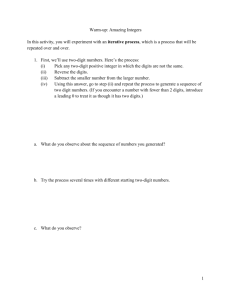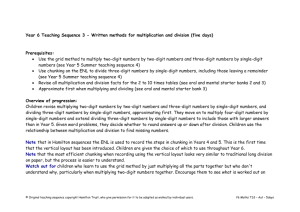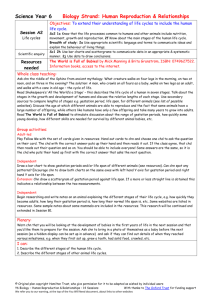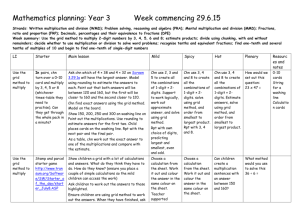Autumn TS 9 - Hamilton Trust
advertisement
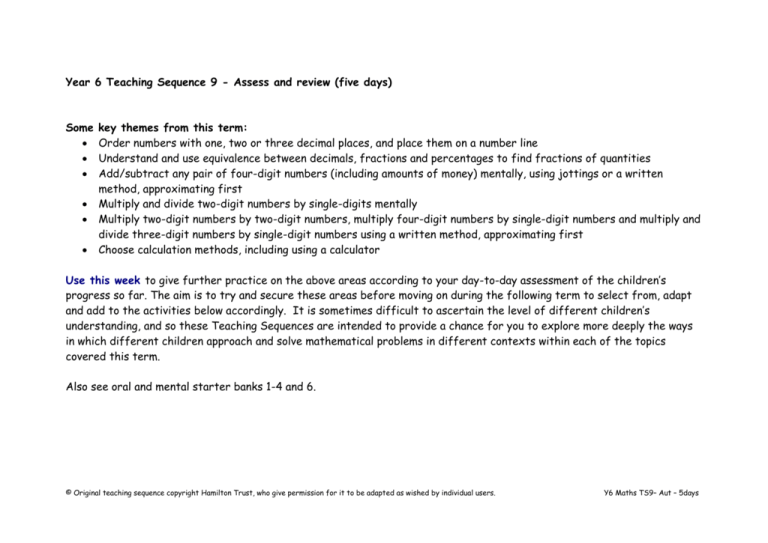
Year 6 Teaching Sequence 9 - Assess and review (five days) Some key themes from this term: Order numbers with one, two or three decimal places, and place them on a number line Understand and use equivalence between decimals, fractions and percentages to find fractions of quantities Add/subtract any pair of four-digit numbers (including amounts of money) mentally, using jottings or a written method, approximating first Multiply and divide two-digit numbers by single-digits mentally Multiply two-digit numbers by two-digit numbers, multiply four-digit numbers by single-digit numbers and multiply and divide three-digit numbers by single-digit numbers using a written method, approximating first Choose calculation methods, including using a calculator Use this week to give further practice on the above areas according to your day-to-day assessment of the children’s progress so far. The aim is to try and secure these areas before moving on during the following term to select from, adapt and add to the activities below accordingly. It is sometimes difficult to ascertain the level of different children’s understanding, and so these Teaching Sequences are intended to provide a chance for you to explore more deeply the ways in which different children approach and solve mathematical problems in different contexts within each of the topics covered this term. Also see oral and mental starter banks 1-4 and 6. © Original teaching sequence copyright Hamilton Trust, who give permission for it to be adapted as wished by individual users. Y6 Maths TS9– Aut – 5days Objectives: Understand what each digit represents in a number with up to two decimal places Begin to recognise and use numbers with three decimal places Recognise equivalence between fractions e.g. between 1/16s, 1/8s, 1/4s and 1/2s; 1/100s, 1/10s and 1/2s Multiply two-digit numbers by single-digit numbers by partitioning, e.g. 47 × 6 = (40 × 6) + (7 × 6) Divide two-digit numbers by single-digit numbers, including those leaving a remainder Give an answer to a division as a mixed number, e.g. 39 ÷ 4 = 9¾ Approximate first before calculating Revise using the grid method to multiply three-digit numbers by single-digit numbers and to multiply two-digit numbers by two-digit numbers Use the grid method to multiply four-digit numbers by single-digit numbers Using chunking on the ENL to divide three-digit numbers by single-digit numbers, including those leaving a remainder Revise adding two numbers with the same number of decimal places using vertical addition, including amounts of money, e.g. £35.75 + £26.78 Revise subtracting four digit numbers by counting up, e.g. 5431 – 2789 Choose mental, written or calculator methods to work out addition and subtraction calculations Whole class Group activities Paired/indiv practice Resources Give chn a set of digit cards, and ask them to take out 3, 4, 5 and 6 and put the rest aside. What is the biggest number that you can make using three or more of these digits, between 3 and 4? (3.65) Write the number on your whiteboards. And the smallest? (3.45) Work with your partner to make three numbers between. Show chn a line from 3 to 4 with tenths marked (see resources). Invite chn up to the board to place their numbers, using the tenths to help. What’s the smallest number with three Group of 4-5 children Ask chn to divide their whiteboards into twelve parts (a four-by-three grid) and to write a number with two decimal places between 1 and 2 in each part. Ring any numbers that: are between 1.2 and 1.3; round to 1.5 to the nearest tenth; are between 1.7 and 2; has four digits; are nearer to 1 than 2; are nearer to 1.4 and than 1.5 etc. Ask chn to use three of the digits 4, 5, 6 and 7, to make as many numbers with two decimal places between 5 and 6 as they can. They draw a number line from 5 to 6 and place them on it. They use all four digits to make two numbers with three decimal places and place them on the same line. Easier: Chn use place the numbers on a line with tenths marked (see Digit cards 3-4 number line with tenths marked 5-6 number line with tenths marked (see resources) © Original teaching sequence copyright Hamilton Trust, who give permission for it to be adapted as wished by individual users. Y6 Maths TS9– Aut – 5days decimals places between 3 and 4 that we can make using these four digits? And the largest? Work together to place these on the line. Show chn a line from 0-1, marked in tenths (see resources). Where would we mark 50% of the way across this line? How do you know? Mark on 50% below the line and ½ above the line. Where would mark 25% of the way across this line? How did you work it out? Draw out the equivalent fraction of ¼, and mark both on the line. Where would we mark 0.1 on this line? How do you know? What fraction is equivalent to 0.1? And percentage? Mark 0.1 and 1/10 above the line and 10% below the line. If you were asked to find 80% of a quantity, how would you work it out? Discuss this with your partner. Take feedback. Draw out for example knowing that 80% is equivalent to 8/10, finding 1/10 and multiplying by 8. Mark 8/10 and 80% on the line. If you were asked to multiply a quantity by 0.3, how would you do this? Talk to your partner. Take feedback. Draw out for example knowing that 0.3 is equivalent to 3/10, finding 1/10 and multiplying by 3. Mark 3/10 and 0.3 on the line. So we can use our knowledge of equivalent The first child to ring all twelve numbers wins. Repeat. Easier: Sketch a number line from 1 to 2 to help, and play with one place decimals to begin with. Harder: Encourage chn to include a few numbers with three decimal places. Group of 4-5 children Fuel has gone up a lot over the past five years. One report says that LPG gas has gone up by 150% over the last 10 years. How can this be possible? If it was £20 per bottle 10 years ago, and it had gone up by 100%, how much would it be now? So what do you think the current price is? What if it had gone up by 200%? So a price can be increased by more than 100%, but it’s not often that we hear about this, as prices usually increase that much over a longer period of time. Can a price be decreased by more than 100%? Why not? A chef has a recipe for chicken biryani and rice for 10 people. He needs to increase the quantities by 150%. How many people will this feed? Display the recipe for 10 people: 2 kg of boneless skinned chicken breast 4 medium onions 500ml plain yoghurt resources). Harder: Ask chn to use the digits 4, 5, 6 and 7, to make as many numbers between 5 and 6 as they can. They place them on a number line (see resources). Chn mark on a 0-1 line (marked in tenths) as many equivalent fractions, decimals and percentages as they can. They then use these equivalents to help them find the quantities, writing which equivalent they used to help them (see resources). Easier: Slightly easier activity sheet with easier fractions, percentages and amounts to work with. Harder: Slightly harder activity sheet with harder fractions, percentages and amounts to work with. © Original teaching sequence copyright Hamilton Trust, who give permission for it to be adapted as wished by individual users. 0-1 line, marked in tenths (see resources) Activity sheets (see resources) Y6 Maths TS9– Aut – 5days fractions, decimals and percentages to find fractions and percentages of amounts, using whichever equivalent is easiest to work with. Write the digits 7, 8 and 9 on the board. What two-digit by single-digit multiplication could we make using these digits? Take one suggestion and write it on the board. Can you think of a multiplication with an answer greater than this? Work in pairs to find the multiplication with the greatest possible answer that you can. Take feedback. Discuss how 9 x 87 gives a greater answer than 8 x 97, as in the first example both parts of the twodigit number are multiplied by 9, the biggest possible number. Point to the original multiplication. Can you think of a multiplication with an answer smaller than this? Work with a partner to find the 2 tsp (10ml) chilli powder 2 tsp (10ml) garam masala 2 tbsp (30ml) grated fresh ginger 2 tbsp (30ml) garlic paste 2 tsp (10ml) turmeric 8 tbsp (120ml) ghee (or butter) 4 cups basmati rice 2 litres water 4 tsp (20ml) finely chopped fresh coriander Ask chn to work as a group (giving several ingredients to each pair) to work out the quantities needed for 25 people. Harder: Increase the quantities by 120%, for 22 people. Group of 4-5 children We’re going to write our 36 times table! Record the first few facts in the way that you normally record times tables: 1 times 36 is 36 2 times 36 is 72 3 times 36 is 108. or: 36 × 1 = 36 36 × 2 = 72 36 × 3 = 108. How can we work out 4 times 36? What fact do we already have to help us? And how can we work out 5 times 36? Continue adding other multiples until Challenge chn to come up with at least five two-digit by single-digit multiplications with answers between 500 and 700, and then at least five two-digit by single-digit divisions with answers between 10 and 15. Easier: Multiplications with answers between 100 and 500. Divisions with answers between 5 and 10. Harder: Multiplications with answers between 700 and 800. Divisions with answers between 15 and 20. © Original teaching sequence copyright Hamilton Trust, who give permission for it to be adapted as wished by individual users. Y6 Maths TS9– Aut – 5days multiplication with the smallest answer that you can. Repeat this time trying to find the two-digit by single-digit divisions with the biggest and smallest possible answers. Write the digits 5, 6, 7, 8 and 9 on the board. What do you think is the biggest four-digit by single-digit multiplication we can make using these five digits? Ask chn to work in pairs for a while and then write 8765 × 9 and 9765 × 8 on the board. Which of these do you think will have the bigger answer, or do you think they will both give the same answer? Ask chn to work out the answer to each and discuss why one gives a bigger answer than the other. Take feedback and draw out that in the first part each of the four-digit numbers is being multiplied by 9, whereas in the second each part is only multiplied by 8, so the first gives a bigger answer. Use these five digits to make the smallest four-digit by single-digit multiplication that you can. Ask chn to work in pairs and then take feedback. Now use four of these digits to make a threedigit by single-digit division with the biggest answer that you can. After chn have been working for a while ask them what they have you have the 36 times table up to 10 times 36. What division facts can we now write? Ask chn to write these at the side. How many 36s are in 396? What can we use to help? How many 36s are in 720? 1800? Easier: Write the 24 times tables. Harder: Write the 76 times table. Group of 4-5 children Write the following grid multiplication on the flipchart in advance: × 5000 300 30 5 3 15,000 900 90 15 16,002 Cover 5000, 300, 30, 5 and 3 with Postit™ notes. On the following pages do the same for 4 x 2435 and 4 x 3576. Show this to the chn. Ask them to discuss in pairs what numbers might be hidden and why. What two numbers might be multiplied together to make 15,000? Remember that one of them is a multiple of 1000 and the other a single-digit. Agree that the numbers could be 5000 and 3 or 3000 and 5. What numbers might have been multiplied together to make 900? List possibilities, 900 × 1, 100 × 9, and 300 × 3. So what must the single-digit on the left be? And the multiple of 1000? And 100? So what are the other missing Ask chn to work in fours to roll a dice to generate five digits. They then work in pairs to use the digits to make the biggest fourdigit number by single-digit number multiplication, two-digit by two-digit multiplication and the biggest three-digit number by single-digit division that they can using four of the digits. They compare their results with the other pair. Repeat. Easier: Generate four-digits to make three-digit number multiplied/divided by single-digit number calculations, finding the biggest multiplication that they can and the smallest division. © Original teaching sequence copyright Hamilton Trust, who give permission for it to be adapted as wished by individual users. Prepared flipchart as opposite and Post-it™ notes Dice Y6 Maths TS9– Aut – 5days found about the divisor (the number they are dividing by). Do you want it to be as big as possible or as small as possible? If you split a number in small groups will you have more or fewer groups than if you split the same number into larger groups? Ask chn to continue working on the problem. Take feedback, focusing on how chn decide where to place each digit. numbers? Remove the Post-its™ to check. Ask chn to work on the next two examples in pairs. In advance draw the following division on the flipchart: 459 ÷ 6 = 76 r 3, covering 459 and 6 and the labels of jumps on the ENL with Post-it™ notes. r3 0 Ask chn to make the biggest and smallest four-digit plus four-digit total they can using the digits 2, 3, 4, 5, 6, 7, 8 and 9 (18,395 and 6047). Is it possible to make a total under 6000? Why not? Work in pairs to try and make a four-digit plus four-digit addition with a total as close to 12,000 as you can. (It’s possible to make 11,996!) Take feedback and ask chn to share how they decided where to 420 456 459 Ask chn to discuss in pairs what the division might be. We can work out the first number quite easily by looking at the line. If the answer is 76 r 3, what might the labels to the two jumps be? Repeat with 419 ÷ 9 and 678 ÷ 8. Easier: Multiplications: 2 x 2335, 3 x 2335, and 4 x 3554. Divisions: 279 ÷ 6, 200 ÷ 9 and 197 ÷ 8. Group of 4-5 children Write the following calculations on the flipchart: 32,498 + 67,987 5421 × 20 569 ÷ 7 482 × 1.5 7.6 × 4.7 42 ÷ 0.7 Chn roll a 0-9 dice four times to make a four-digit number, and repeat to make a second. They record a subtraction, largest number first and an addition. Repeat until they have three additions and three subtractions using four-digit numbers. Ask chn to look at their calculations and © Original teaching sequence copyright Hamilton Trust, who give permission for it to be adapted as wished by individual users. 0-9 dice Y6 Maths TS9– Aut – 5days put each digit. Discuss the thousands digits and how if they are trying to make totals close to 12,000 for example, it might be that using 6 and 5, 7 and 4, 8 and 3 or 9 and 2 in the thousands place might give an answer close to 12,000 because the three-digit parts of the numbers may have a total close to 1000, taking the total over or close to 12,000. Challenge chn to use the same digits to create a four-digit subtract four-digit answer as as small as they can. 3456 - 2987 3 [2990] 10 [3000] 456 469 After they have been working in pairs for a while, discuss how they are deciding where to place the each digit. What can you say about the thousands digits? If we want the smallest difference that we can, what can you say about the three-digit part of the larger number? And the three-digit part of the smaller number? Repeat, this time trying to find the greatest difference that they can. 21,000 – 18,997 You can use a calculator to work out the answers to only three of these calculations. Which would you choose and why? Ask chn to work in pairs to answer each calculation, using a calculator for only the three they have chosen, estimating the answer to each calculation first. Challenge them to come up with four calculations (+, -, × and ÷) with more digits that they are used to calculating with, but easy enough not to use a calculator. Easier: Write the following calculations on the flipchart: 32,498 + 67,987 5421 × 10 427 ÷ 7 482 × 20 7.6 × 4.7 42 ÷ 0.7 20,000 – 19,997 predict which will give the biggest answer and the smallest answer, and then to write them in order. They use whichever methods they feel most comfortable with to find the answers. Easier: Chn only predict the largest and smallest answers. Harder: Chn also write a subtraction with a smaller answer than any of their calculations and an addition with an answer greater than any of their calculations. © Original teaching sequence copyright Hamilton Trust, who give permission for it to be adapted as wished by individual users. Y6 Maths TS9– Aut – 5days


